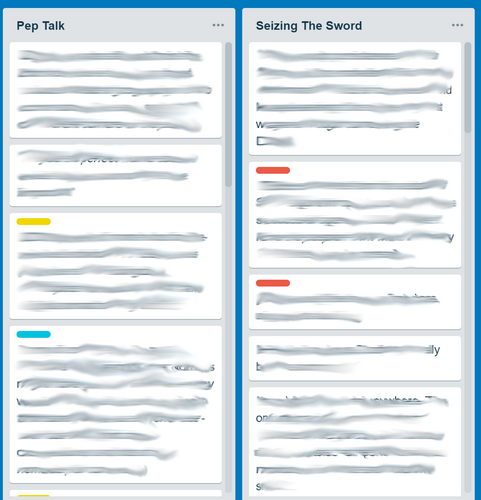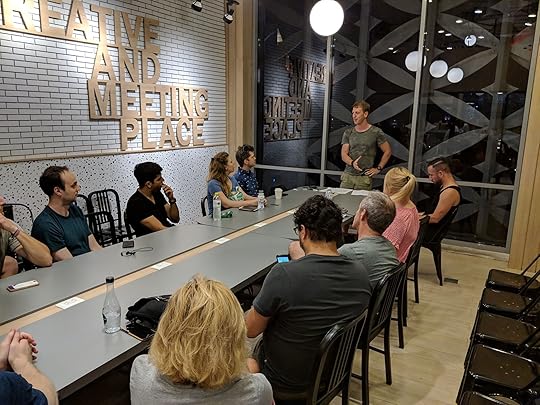Nathan Rose's Blog
October 10, 2020
Don’t Write A Book… Unless You Know Why You Are Writing It
This is a reflection about goal-setting and why it is so crucial for authors.
You can do all the productivity hacks – deactivate your social media, block notifications on your smartphone, buy a fancy writing desk, go to a writer’s retreat to shield yourself from distractions, or give up other time-consuming activities…
…but if you don’t have a strong “why”, then it will all be for nothing.
Here are some of the barriers you will hit if you don’t know why you are writing your book.
(By the way, these all come from my own personal experience, when I failed to have a strong “why” when I was writing one of my own books).
#1 – Lack Of Motivation
Writing a book is a huge amount of work.
Without knowing your “why”, the initial excitement of starting a project quickly fades once the daily grind required to actually achieve it sets in.
You need to know what outcome you are seeking.
What will having this book mean to you?
Why will it get you to spend time writing, instead of the myriad of other ways you could spend your time?
If you don’t have this, you won’t have the requisite grit to keep going when it gets tough.
Lesson: don’t just set a goal — tie it to an emotional reason for achieving it.
#2 – You’ll Find It Hard To Decide On The Format
There are many ways to write a book.
Depending on your “why”, your message might be best communicated through:
A work of fiction, with a moral to the story
A narrative non-fiction book (such as Liar’s Poker, by Michael Lewis)
A “big idea” non-fiction book (such as The Tipping Point, by Malcom Gladwell)
An “authoritative” non-fiction book (such as The 4-Hour Work Week, by Tim Ferriss)
If you don’t know what you want to achieve, it will be hard to see clearly what form the book should take. You won’t have a compass pointing to “true North”.
You need to have a stable answer for the question of “what kind of book are you going to write?”
Lesson: If you don’t even know what kind of book you’re trying to write, it’s pretty hard to write it.
#3 – Other Projects Will Have A Clearer Path Forward
Tony Robbins (the author and motivational speaker) said: “Complexity is the enemy of execution”.
That is so true.
When faced with how to spend your time, you will tend to avoid the feeling of ambiguity, and gravitate towards projects which you know more clearly.
Lesson: Without knowing your “why”, the ambiguity can crush you.
How A Writing Coach Can Help
The smart way to proceed when the pathway is not clear is to enlist the help of a teacher who has done the thing already.
Great teachers can guide the student and correct their mistakes before they make them — saving the student a great deal of time and preventing frustration.
While there is plenty of free (or cheap) information out there… a real teacher’s assistance is much more effective. With a teacher, the advice is far more tailored to YOU, and the act of paying money is a vital commitment to getting the goal done.
You may understand this very well already, in other areas of life.
People take private dance lessons to help them improve rapidly…
…or they get a personal trainer to quickly improve their physical fitness…
Well, writing coaches can help with the same thing.
A writing coach can help draw out your “why” for your book, thereby give you greater understanding of your goal, and get you on track to achieving it.
The post Don’t Write A Book… Unless You Know Why You Are Writing It appeared first on Nathan Rose.
October 9, 2020
How To Outline Your Book, Using Trello
In November 2017, I attended the incredible CreativCastle Writer’s Retreat in Rappotenstein, Austria.
Along with several other authors, I spent the fortnight exploring the amazing medieval fortress, taking meandering strolls through the woods, and writing as many words as I could manage in between sumptuous communal meals.
Everyone in the castle was writing fiction, apart from me – the sole non-fiction writer.
Since I was doing non-fiction, I believed that plotting and outlining didn’t really apply to me. “That’s all fiction stuff.”, I thought.
But I was wrong.

Many writers may be able to identify with the following feeling…
You dutifully knock out hundreds of words, or even thousands of words every day.
You feel productive, as you see the word-count clocking upward.
But then, you get to a certain point and realise these words aren’t adding up to anything coherent…
… and you don’t know what to do next.
That was me. I was “just writing”, without an outline. I was writing whatever felt good in the moment.
I had to toss out almost everything, because although I had a lot of words, those words didn’t add up to anything that resembled a book.
I now realise that writing without an outline is like building a house without a blueprint. If you were to tell a builder to “just build”, he would laugh at you – and for very good reason. A builder will do things very differently depending on whether he is building a mansion, a studio apartment, or an igloo.
Yet this is basically what so many writers do every single day – they “just write”, without much of a plan of where it’s all heading.
Yes, writers will discover new things through the creative act of writing, but you still need to begin with the end in mind. Otherwise you just end up with a great big mess – like I did.
Outlining can be a pain though. It can take ages to shift ideas around, and you can very easily lose track of the scenes and where they fit. It’s why so many authors don’t do it. But luckily, they have an app for that. It’s called Trello.
Think of Trello as being a computer-based pinboard – the kind you might have hanging on your wall, to stick to-do-lists, reminders, and notes-to-self.
In this article I will share how to use Trello to produce strong book outlines which will save you a ton of time.
Trello basically works at three levels.
– Boards: which I use for each individual book.
– Lists: which I use for each chapter, or plot point.
– Cards: which I use for each ‘idea’ or story within the book.
To get started, go to www.trello.com and create your account. Then, create a new Board. Each Boards will eventually display everything in your book’s outline, all in one place.

Next, create your Lists within this board. Lists display across the Board, in columns. Think of Lists as your chapters, or your plot points.

Finally, you will place your individual ideas, as Cards, under each of these Lists.
You’ll probably end up with dozens of Cards, organised under each of the Lists.

You might be wondering what’s so special about any of that – can’t you do all this within a Word Document? Well yes… but here’s the real beauty of Trello: how painless it makes re-organising, when you realise that an idea fits somewhere else.
As you go, you can easily pick up a Card (idea) and move it to another part of the Board (the book), or even pick up an entire List (chapter / plot point). Just click, drag-and-drop – and bam! – your material has been moved.
You get to see the entire plan all at once, and organise it into a perfect blueprint before you start writing. It really is amazing.

One last tip to help advanced users get the most out of Trello: try adding “Tags” to Cards. These can be set to different colours.
I like to use Tags to annotate each story and the emotion that the story elicits.
I didn’t want to over-complicate it, so I just set three colours:
– Red for triumph
– Blue for difficulties and trials
– Yellow for entertaining stories

By using Trello, I could see, at a glance a 10,000-foot view of my book before writing it!
A solid outline can then be sent to an editor or beta readers, who can give further feedback on the direction – before sitting down and writing that crucial first draft.
By doing it this way, you can make sure that you don’t go off in totally the wrong direction… like I did!
I’d love to hear how you use Trello for yourself. Good luck with outlining your next book!
The post How To Outline Your Book, Using Trello appeared first on Nathan Rose.
October 8, 2020
Why You Should Write Your Book With Your Readers
“A book should be an article before it’s a book, and a dinner conversation before it’s an article. See how things go before going all in.” — Ryan Holiday, Perennial Seller
Do You Want To Write A Book?
Today, I want to share an idea with aspiring non-fiction authors, which will help them (and their books) be more successful.
This is not to do with the “craft” of the writing itself – although the quality of the book’s content is, of course, critical.
But plenty has already been said about how books can be structured and sentences constructed to maximise their impact.
Instead, I want to focus on a strategy to ensure that what is written actually gets read, by real readers.
Throughout my journey in self-publishing, I have read a lot about “book marketing”.
Most of it concerns how to game the search algorithms to make books artificially appear #1 in a category on Amazon, long enough to call it a (quote, unquote) “bestseller”.
Shortcuts like these are seductively appealing to authors, because they tend to want to spend as little time as possible on the marketing, so they can spend more time on the actual writing.
They want the result (bestseller status) with the least possible effort.
The trouble is, this only work in the short-term. It won’t keep a book selling for very long.
Gaming the algorithm may produce a spike in visibility, but a book isn’t going to stay there and sell consistently if that’s all you do.
So, I want to propose an alternative which is geared towards longer-term success.
It involves conscripting your target readers to help with the creation of the book, so that the book becomes a joint effort between the author and the intended audience.

Assembling a focus group of your target audience is a great way to involve your readers in the writing.
This idea has hardly been mentioned in the realm of book publishing. However, other fields of creative endeavor already understand it very well. There is even a name for it: “co-creation”.
I contend that non-fiction authors can apply co-creation for themselves.
The results you can expect through book co-creation are:
Readers who are more interested in the book, even before it has been finished.
A better book: more engaging, more shareable, higher quality.
Both are important aims. If you are reading this, I assume you want people to buy, read, and care about the book you are writing.
More Interest & A Better End Product
Here’s how co-creation works: instead of a creator making a thing, and then trying to figure out how to sell it, the philosophy of co-creation first asks customers what they want, before the creator goes away and makes it for them. By giving customers a seat at the table, the creator doesn’t need to rely on guesswork to figure out what will be appealing.
The point is not only to make a better product, but to also make people feel like that product belongs to them.
In exceptional cases, the product can even become part of their identity.
The best entrepreneurs use co-creation extensively. Before launching a new product or service, they extensively test it among their target users. They run surveys and collect feedback. They run show concepts, build prototypes, and develop minimum viable products.
The entertainment industry understands co-creation too. Before Hollywood spends tens of millions of dollars on the next blockbuster, they test the script, test different endings, and they measure reactions. Then, they use it all to make a better film. They do not trust the gut feeling of a lone script-writer — no matter how much of a genius he or she might be. There is simply too much at stake to risk a flop. To justify the necessary upfront investment, they need to know (not hope) it will be a success.
Co-creation means that by the time launch day comes, the creation (whether a business, a film, or anything else) has been molded into what the customer wants. And, because the customer has had this role in the development, they also feel a strong sense of ownership over the end result.
Unlike startups and Hollywood, authors aren’t usually spending millions on their book launch, but they are investing a significant amount of their time. Time is not something you want to waste.
You should do everything you can to give your book the best possible chance of success, before going to all the trouble of writing it.
Let The Reader Tell You What They Want
But most authors do the opposite.
They write their book first, and only once the book is done do they start thinking about how they can do the marketing for it. “I’ve got this book. Now, how do I sell it?”.
Unfortunately, by this point, it is too late. If you write a book which nobody wants, then no amount of clever marketing cannot overcome that. It’s like trying to convince people to buy a useless invention, or watch a terrible movie.

People are pretty good at knowing what they want, and very willing to share this information if they are asked.
In a world where advertisers appear everywhere, insisting that people must buy this or that, creators that listen first (instead of shout) automatically stand out from the noise.
Creators like these are rare, and are therefore valued.
Do Not Isolate Yourself
Unfortunately, many aspiring authors have a horrible habit of isolating themselves from the possibility of getting such early feedback.
To focus on their project, they remove themselves from contact with the outside world. “I don’t want to be distracted”, they reason.
Removed from their friends and potential readers, it is little wonder when they are bereft of good ideas.
“Numberless artists toil away in total emotional and physical solitude, disassociated not only from other humans, but also from the source of creativity itself.” — Elizabeth Gilbert, Big Magic
“Writer’s block” hardly ever happens to authors who put themselves in an environment where they can talk about their ideas with others. It’s one of the reasons why you might want to consider writing your book with a coach, or alongside other authors, or your target readers.
Of course, there needs to be some “alone time” for Deep Work as well. It’s a balancing act.
You can’t spend all your time writing. If you do, you risk creating something which is of no interest to readers.
And you also can’t spend all your time talking about your work — or you’ll never get any writing done.
The best books are not written in complete solitude.
For proof, just pick up any popular book and flip to the acknowledgments section. Look at how many people the author thanks — editors, early readers, publishers, friends and family.
Invariably, there is often some version of “I couldn’t have done it without you” — and they mean it.
It adds up to the following conclusion: creation is a collaborative endeavor.
Give People A Way To Be Involved
A lot of people would like to write a book, but the vast majority will never do it. They don’t have the time, they don’t have the patience, they don’t know where to start — all the usual reasons that explain the gap between those who merely wish and those who do.
But to those who have the necessary follow through, the dreamers present an opportunity — by asking for their advice (and listening to it), an author can involve those who would like to write a book in the book-writing process.
Those you reach out to may not get their name on the front cover, but they can still get to see themselves in print in the acknowledgments.
Give them this gift, and watch them become loyal advocates for your book.
Individual Genius vs. Group Wisdom
The idea of writing a book based on early reader feedback doesn’t get universal acceptance. The following objection is often leveled:
Real art comes from the individual genius of the artist. The public don’t know what they want until they see it. Therefore, asking them what they want isn’t going to create anything revolutionary.
Related to this, the following (possibly apocryphal) quote was attributed to the founder of the Ford Motor Company, and pioneer of the assembly line technique of mass automobile production:
“If I had asked people what they wanted, they would have said faster horses.” – Henry Ford
If you want to disrupt the status quo and create entirely new (like a motor car, in a world filled with horses), then Ford might be right. Relying on what everyone else’s feedback will probably won’t produce a genuine breakthrough.
But you don’t have to do that in order to be successful. Plenty of authors and entrepreneurs make a living from taking something that already exists, and putting a slight twist on it, or giving their own take on it.
Ultimately, it depends on your goal and how much risk you are willing to take on with your book. If you are planning to rewrite the rules of literature, and create something so unlike anything that has come before, then you should realize that this is the much more difficult path.
For every Henry Ford who changed the world, there are thousands of failed entrepreneurs who were confident – but who you have never heard of, because their radical idea never caught on.
The same goes for books.
Most successful books follow genre expectations. Working within “the rules of how to write” still allows for plenty of creative freedom.
Don’t worry about reader feedback stifling your creativity.
Write your book with your readers.
The post Why You Should Write Your Book With Your Readers appeared first on Nathan Rose.



